Yamaha XT 225 Serow Valve Adjustment
Originally posted to El Cantar de la Lluvia on Thursday, April 19, 2007
"But Paul, you have an XR, what is this XT 225 doing in one of your articles?"
Well, it's a guest, of course! This is Jano's bike, a 2001 Yamaha XT 225 Serow, a faithful and excellent bike that was ready for a valve adjustment.
Jano had noticed some valve noise that occurred during the first few seconds after the bike was started. This is normal, but he wanted to check his valve gap anyway.
He came to my house, and armed with the shop or service manual of the Yamaha XT 225 Serow (alternative link), we got to work.
First, remove the seat.

The fan is there to cool the engine, since valve adjustments should be done with the bike stone cold, and he'd ridden it to my house.
Remove the gas tank fairing, then the tank itself. Since everything is dirty down there, we must clean it.
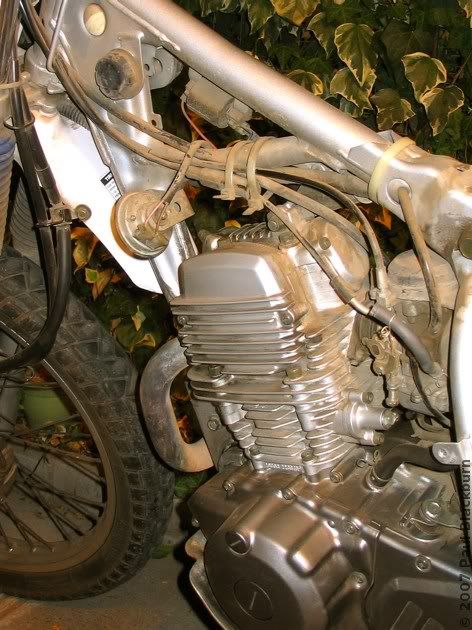
That's what we did: toothbrushes and de-greasing spray.
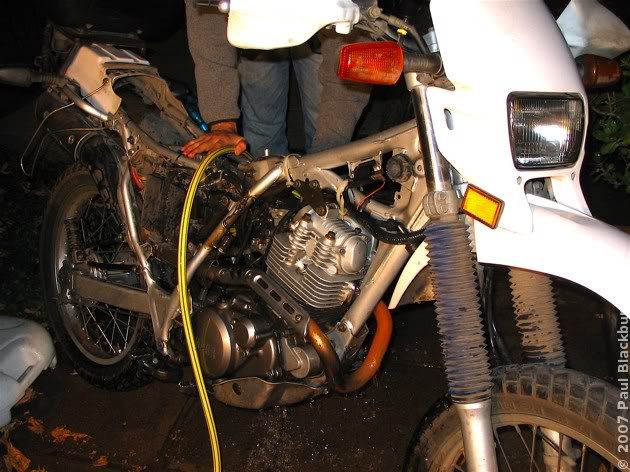
With everything completely dry, and the engine at ambient temperature, we removed the spark plug. I think the mix might be a bit poor.
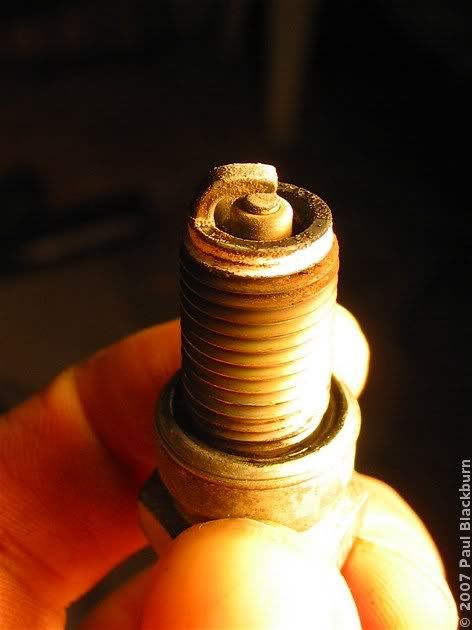
Then, remove the two covers on the left side of the engine. Using a socket and an extension bar, just as you do with the XR, rotate the engine in the anti-clockwise direction, until the "T" mark is aligned with the mark visible through the top hole.
The pistom must be on its compression stroke as you align the T mark. To make sure that this is the case, both valve rockers should have some play. If they do, you're on the compression stroke. If they don't, you're on the exhaust stroke, and you should turn the engine one more time.

Remove the valve rocker covers. Here's the exhaust one.
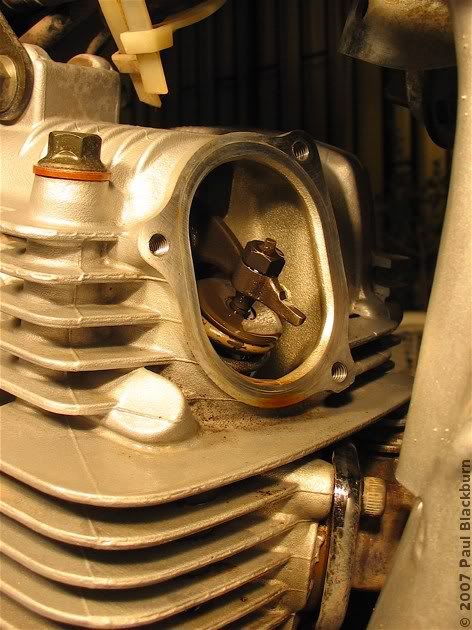
And the intake one.
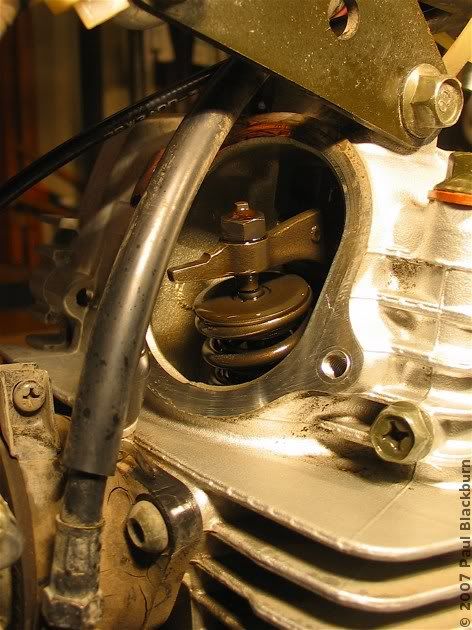
Loosen the lock nut with a 10 mm wrench. It will be necessary to turn the adjustment screw. For some strange reason this piece has a square head. Yes, you read that right. I had to make a simple tool to give it the right position. You can do it with needle-nosed pliers, but you'll go insane trying.
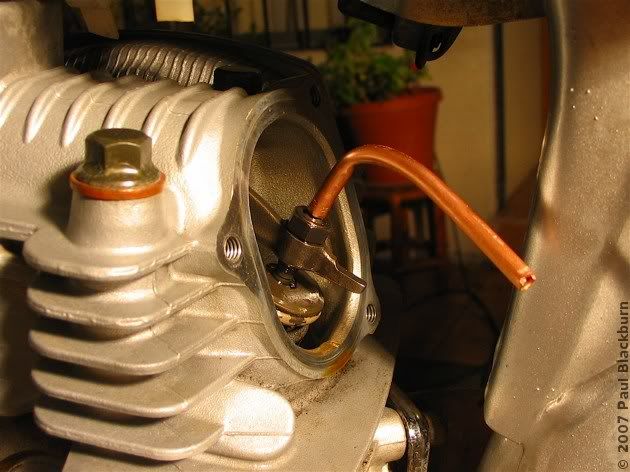
I made the tool out of copper tube, the type you use in refrigerators, and needle-nosed pliers. I inserted one of the pliers' jaws into the tube, and thus flattened one quarter of the tube's circumference. Pull it out, rotate 90º, squeeze. You can thus make a round tube into a square profile. The ridges on the pliers help file away any irregularities. Not bad!
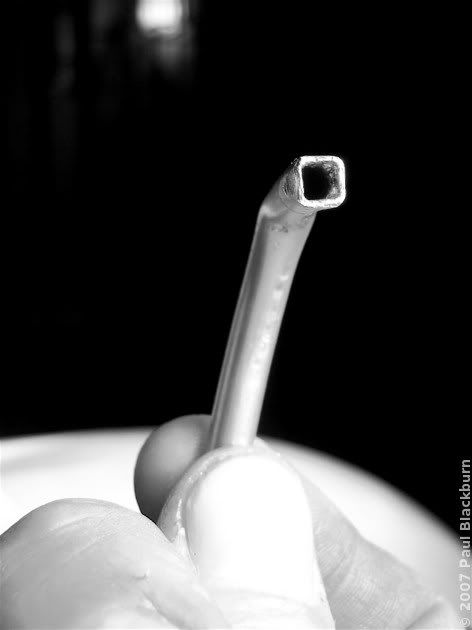
To learn how to correctly use feelers to set the valve separation, read the article on the same procedure on the XR. We found that the exhaust valve gap was too large, so I adjusted it. The intake one was within the range specified by the shop manual.
And thus concludes the valve adjustment of this pretty bike.
"But Paul, you have an XR, what is this XT 225 doing in one of your articles?"
Well, it's a guest, of course! This is Jano's bike, a 2001 Yamaha XT 225 Serow, a faithful and excellent bike that was ready for a valve adjustment.
Jano had noticed some valve noise that occurred during the first few seconds after the bike was started. This is normal, but he wanted to check his valve gap anyway.
He came to my house, and armed with the shop or service manual of the Yamaha XT 225 Serow (alternative link), we got to work.
First, remove the seat.

The fan is there to cool the engine, since valve adjustments should be done with the bike stone cold, and he'd ridden it to my house.
Remove the gas tank fairing, then the tank itself. Since everything is dirty down there, we must clean it.

That's what we did: toothbrushes and de-greasing spray.

With everything completely dry, and the engine at ambient temperature, we removed the spark plug. I think the mix might be a bit poor.

Then, remove the two covers on the left side of the engine. Using a socket and an extension bar, just as you do with the XR, rotate the engine in the anti-clockwise direction, until the "T" mark is aligned with the mark visible through the top hole.
The pistom must be on its compression stroke as you align the T mark. To make sure that this is the case, both valve rockers should have some play. If they do, you're on the compression stroke. If they don't, you're on the exhaust stroke, and you should turn the engine one more time.

Remove the valve rocker covers. Here's the exhaust one.

And the intake one.

Loosen the lock nut with a 10 mm wrench. It will be necessary to turn the adjustment screw. For some strange reason this piece has a square head. Yes, you read that right. I had to make a simple tool to give it the right position. You can do it with needle-nosed pliers, but you'll go insane trying.

I made the tool out of copper tube, the type you use in refrigerators, and needle-nosed pliers. I inserted one of the pliers' jaws into the tube, and thus flattened one quarter of the tube's circumference. Pull it out, rotate 90º, squeeze. You can thus make a round tube into a square profile. The ridges on the pliers help file away any irregularities. Not bad!

To learn how to correctly use feelers to set the valve separation, read the article on the same procedure on the XR. We found that the exhaust valve gap was too large, so I adjusted it. The intake one was within the range specified by the shop manual.
And thus concludes the valve adjustment of this pretty bike.
Labels: mechanics




 The Lagoons of the Santuario de la Naturaleza 2: Laguna Los Ángeles
The Lagoons of the Santuario de la Naturaleza 2: Laguna Los Ángeles Race Day At Leyda 4
Race Day At Leyda 4 El Tabo and the Central Hidroeléctrica El Sauce
El Tabo and the Central Hidroeléctrica El Sauce Exploring The Hills Around Lampa
Exploring The Hills Around Lampa A Different Route To Baños De Colina
A Different Route To Baños De Colina The Mines of the Cuesta La Dormida
The Mines of the Cuesta La Dormida The Frozen Lagoons of the Santuario de la Naturaleza
The Frozen Lagoons of the Santuario de la Naturaleza Second Mass Demonstration "For A Fair Tag"
Second Mass Demonstration "For A Fair Tag" First Mass Demonstration Against The 'Tag'
First Mass Demonstration Against The 'Tag' Enduro In Lagunillas
Enduro In Lagunillas Embalse El Yeso and Termas Del Plomo
Embalse El Yeso and Termas Del Plomo Ride To Peñuelas
Ride To Peñuelas Cerro Chena
Cerro Chena Race Day at Leyda 3
Race Day at Leyda 3 Baños de Colina 2
Baños de Colina 2 Carretera Austral: Epilogue
Carretera Austral: Epilogue The Little Giant and Termas del Plomo
The Little Giant and Termas del Plomo Back on Two Wheels
Back on Two Wheels 2006 Photographic Retrospective
2006 Photographic Retrospective Race Day At Leyda 2
Race Day At Leyda 2  Quantum Optics III in Pucón
Quantum Optics III in Pucón Meseta In Chicureo
Meseta In Chicureo Pick Up Your Beer Bottle And Fuck Off
Pick Up Your Beer Bottle And Fuck Off  Planes And Hills
Planes And Hills Cut-Off Road
Cut-Off Road Lagunillas
Lagunillas Laguna Verde 2
Laguna Verde 2 Ride To Anywhere But Aculeo
Ride To Anywhere But Aculeo Cerro El Roble, Second Attempt
Cerro El Roble, Second Attempt Baños De Colina
Baños De Colina Some Walk On Water...
Some Walk On Water... Race Day At Leyda
Race Day At Leyda Almost Cerro El Roble
Almost Cerro El Roble Off To Curacaví with Andrés
Off To Curacaví with Andrés La Serena, Part 3: Back To Santiago
La Serena, Part 3: Back To Santiago  A Bull, Two Cows and a Chilean Fox
A Bull, Two Cows and a Chilean Fox Escape To Cuesta La Dormida
Escape To Cuesta La Dormida Valve Adjustment
Valve Adjustment La Serena, Part 2B: Valle Del Elqui
La Serena, Part 2B: Valle Del Elqui La Serena, Part 2A: Coquimbo and La Recova
La Serena, Part 2A: Coquimbo and La Recova Mud And Pine Trees
Mud And Pine Trees La Serena, Part 1
La Serena, Part 1 Pimp My Exhaust
Pimp My Exhaust Ride To Laguna Verde
Ride To Laguna Verde Ride To La Mina
Ride To La Mina Ride To Termas El Plomo
Ride To Termas El Plomo Camping in Colliguay
Camping in Colliguay Ride To Portillo
Ride To Portillo Ride To Olmué and Con Con
Ride To Olmué and Con Con Siete Tazas
Siete Tazas Watching The Departure Of The Day That Brought Me Here
Watching The Departure Of The Day That Brought Me Here Buenos Aires Motorbikes
Buenos Aires Motorbikes Ride to Talca with the Adach Group
Ride to Talca with the Adach Group Las Trancas '05
Las Trancas '05 Towers and Hills
Towers and Hills María Pinto, Melipilla, Aculeo
María Pinto, Melipilla, Aculeo Me and my Carb
Me and my Carb




2 Comments:
I've learned that one can use 12-point sockets (or 12-point box-end wrench) on square nuts/bolts. This makes perfect sense when you think about it - a 12-point socket can be thought of as 2 overlapping 6-point ones, or 3 overlapping 4-point ones.
You did well with the copper tube, sure :)
Wouldn't an open end wrench be simple enough?
Post a Comment
<< Home